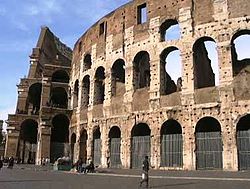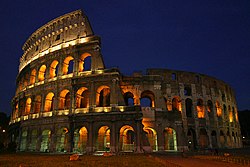Colosseum
From Wikipedia, the free encyclopedia.
- For other uses, see Colosseum (disambiguation). See also the band Colosseum.
The Colosseum or Coliseum, originally known as the Flavian Amphitheatre (lat. Amphitheatrum Flavium), is an amphitheatre in Rome, capable of seating 50,000 spectators, which was once used for gladiatorial combat. Construction was initiated by Emperor Vespasian and completed by his sons, Titus and Domitian, between AD 72 and AD 90. It was built at the site of Nero's enormous palace, the Domus Aurea. The Colosseum's name is derived from a colossus (a 130-foot, or 40-metre, statue) of Nero which once stood nearby. The Colosseum is located at 41.53° N 12.293° E.
Contents |
Construction
The construction of the Colosseum began under the Emperor Vespasian in AD 72 and was completed by his son, Titus, in the 80s AD. It was built at the site of Nero's enormous palace, the Domus Aurea, which had been built after the great fire of Rome in AD 64. Some historians believe that the construction of the Colosseum might have been financed by the looting of King Herod the Great's Temple in Jerusalem which occurred about AD 70. Dio Cassius said that 9,000 wild animals were killed in the one hundred days of celebration which inaugurated the amphitheatre opening. The arena floor was covered with sand, presumably to allow the blood to drain away.
The Colosseum hosted large-scale spectacular games that included fights between animals (venationes), the killing of prisoners by animals and other executions (noxii), naval battles (naumachiae, via flooding the arena) up until AD 81, and combats between gladiators (munera). It has been estimated that several hundreds of thousands died in the Colosseum games.
History of the name Colosseum
The Colosseum's name is derived from a colossus (a 130-foot or 40-metre statue) of Nero nearby. This statue was later remodeled by Nero's successors into the likeness of Sol, the sun god, by adding the appropriate solar crown. Nero's head was also replaced several times by the head of succeeding emperors. At some time during the Middle Ages, the statue disappeared; experts suspect that, since the statue was bronze, it was melted down for reuse.
After the colossus' disposal, the link to it seems to have been forgotten over time, and the name was corrupted to Coliseum in the Middle Ages. Both names are frequently used in modern English, but Flavian Amphitheatre is generally unknown. In Italy, it is still known as il colosseo, but other Romance languages have come to use forms such as le colisée and el coliseo.
Description
The Colosseum measures 48 metres high, 188 metres long, and 156 metres wide. The wooden arena floor was 86 metres by 54 metres, and covered by sand. Its elliptical shape kept the players from retreating to a corner, and allowed the spectators to be closer to the action than a circle would allow.
The Colosseum was ingeniously designed. It has been said that most spectacle venues (stadiums, and similar) have been influenced by features of the Colosseum's structure, even well into modern times. Seating (cavea) was divided into different sections. The podium, the first level of seating, was for the Roman senators; the emperor's private, cushioned, marble box was also located on this level. Above the podium was the maenianum primum, for the other Roman aristocrats who were not in the senate. The third level, the maenianum secundum, was divided into three sections. The lower part (the immum) was for wealthy citizens, while the upper part (the summum) was for poor citizens. A third, wooden section (the maenianum secundum in legneis) was a wooden structure at the very top of the building, added by Domitian. It was standing room only, and was for lower-class women.
After the Colosseum's first two years in operation, Vespasian's younger son (the newly-designated Emperor Domitian) ordered the construction of the hypogeum (literally meaning "underground"), a two-level subterranean network of tunnels and cages where gladiators and animals were held before contests began. Numerous trap doors in the floor provided instant access to the arena for caged animals and scenery pieces concealed underneath; larger hinged platforms, called hegmata, provided access for elephants and the like.
Today the arena floor no longer exists, though the hypogeum walls and corridors are clearly visible in the ruins of the structure. The entire base of the Colosseum covers an area equivalent to 6 acres (160,000 m²). There are also tunnels, still in existence, configured to flood and evacuate water from the Colosseum floor, so that naval battles could be staged prior to the hypogeum's construction. Recent archaeological research has shown evidence of drain pipes connected to the City's sewer system and a large underground holding tank connected to a nearby aqueduct.
Another innovative feature of the Colosseum was its cooling system, known as the valerium, which consisted of a canvas-covered, net-like structure made of ropes, with a hole in the center. This roof covered two-thirds of the arena, and sloped down towards the center to catch the wind and provide a breeze for the audience. Sailors, standing on special platforms, manipulated the ropes on command. The Colosseum incorporated a number of vomitoria — passageways that open into a tier of seats from below or behind. The vomitoria were designed so that the immense venue could fill in 15 minutes, and be evacuated in as little as 5 minutes. Each entrance and exit was numbered, as was each staircase.
There were 80 entrances at ground level, 76 for ordinary spectators, two for the imperial family, and two for the gladiators. Spectators were given tickets in the form of numbered pottery shards, which directed them to the appropriate section. The vomitoria quickly dispersed people into their seats and, upon conclusion of the event, disgorged them with abruptness into the surrounding streets (giving rise, presumably, to the name).
Later history
The Colosseum was in continuous use until 217, when it was damaged by fire after it was struck by lightning. It was restored in 238 and gladiatorial games continued until Christianity gradually put an end to those parts of them which included the death of humans. The building was used for various purposes, mostly venationes (animal hunts), until 524. Two earthquakes (in 442 and 508) caused a great damage to the structure. In the Middle Ages, it was severely damaged by further earthquakes (847 and 1349), and was then converted into a fortress.
The marble that originally covered the façade was burned to make quicklime. During the Renaissance, but mostly in the Baroque age, the ruling Roman families (from which many popes came) used it as a source of marble for the construction of St. Peter's Basilica and the private Palazzi. A famous description is in the saying Quod non fecerunt Barbari, fecerunt Barberini; "What the Barbarians weren't able to do, was done by the Barberinis" (one such family).
The Venerable Bede (c. 672–735) wrote:[1]
| Quandiu stabit coliseus, stabit et Roma | (As long as the Colosseum stands, so shall Rome); | |
| Quando cadit coliseus, cadet et Roma | (When the Colosseum falls, so shall Rome); | |
| Quando cadet Roma, cadet et mundus | (When Rome falls, so shall the world). |
Note the use of coliseus, i.e. which made the name a masculine noun. This form is no longer in use.
In 1749, in a very early example of historic preservation, Pope Benedict XIV forbade the use of the Colosseum as a quarry. He consecrated the building to the Passion of Christ and installed Stations of the Cross, declaring it sanctified by the blood of the Christian martyrs who were thought to have perished there. Later popes initiated various stabilization and restoration projects. Every Good Friday the pope leads a procession within the ellipse in memory of Christian martyrs. However, there is no historical evidence that Christians were tortured and killed in the Colosseum [2]. It is presumed that the majority of Christian martyrdom in Rome took place at the Circus Maximus.
In 2000 there was a diffused protest in Italy against the death penalty all over the world (in Italy it was abolished in 1948); several manifestations took place in front of the Colosseum. The illumination of the Colosseum is always on, and so it was at that time, but in that period, as a gesture against capital punishment, the local authorities of Rome changed the colour of the night time illumination from white to gold whenever a person condemned to the death penalty anywhere in the world gets commuted or released. [3]
According to the current political division of the center of Rome, the Colosseum is placed in rione Monti.
Hollywood and the Colosseum
The Colosseum has a prominent place in many motion pictures. In 1954's Demetrius and the Gladiators Emperor Caligula sentences the Christian Demetrius to fight in the Colosseum's gladiator games. In the Science Fiction film The Core, the Colosseum is destroyed by intense lightning strikes, which blast it to bits. In director Ridley Scott's 2000 film Gladiator, the Colosseum was re-created via computer-generated imagery (CGI) to "restore" it to the glory of its heyday in the 2nd century. However, many of the buildings depicted surrounding the colosseum never existed.
Flora
The Colosseum has a wide and well-documented history on flora that grows in the amphitheatre. From 1643 on, when doctor Domenico Panaroli started to make a list of all plants in the Colosseum, there has been a total of 684 species. The peak was in 1855 (420 species), which decreased to 242 today. 200 of the species were present from the time that the first list was compiled through now.
The variety of different kinds of plants can be explained by the change of climate in Rome throughout the centuries. Bird migration, flower blooming, the growth of Rome that caused the Colosseum to not be on the outside skirts of the city anymore and deliberate transport of species are other ways to clearify the wide stream of plants.
See also
External links
- For broadband: Interactive high quality fullscreen QTVR panoramas
- also available for low bandwith in java: http://rome.arounder.com/colosseo/java.html
- The Roman Colosseum, Rome virtual reality movies and pictures
- The COLOSSEUM – a site on the Roman amphitheatre
- A cut away view showing internal construction
- Colosseum's Fauna









